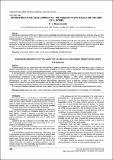| dc.contributor.author | Kravchenko, Valentin Viktorovich | |
| dc.coverage.spatial | Брест | |
| dc.date.accessioned | 2024-02-14T12:11:39Z | |
| dc.date.available | 2024-02-14T12:11:39Z | |
| dc.date.issued | 2023 | |
| dc.identifier.citation | Kravchenko, V. V. Microstructure development of the cement paste based on the unit cell model / V. V. Kravchenko // Vestnik of Brest State Technical University. – 2023. – № 3 (132). – P. 48–53 : il. – Bibliography: p. 52–53 (13 titles). | |
| dc.identifier.uri | https://rep.bstu.by/handle/data/40741 | |
| dc.description | Кравченко В. В. Моделирование микроструктуры цементного камня на основе модели элементарной ячейки. | |
| dc.description.abstract | Microstructure development of the cement paste is closely associated with internal processes such as self-desiccation, shrinkage, creep and other internal processes throughout service life of cement-based materials. The ability to accurately model microstructure parameters is key to predicting internal processes of the cement paste. Currently, the most frequently used approaches to microstructural modeling of cement paste are vector and discrete. Both approaches generate and process a random structure of the cement paste, but at the same time are characterized by high computational complexity and time-consuming. It accounts for the fact, that simplified structural models still remain relevant. A unit cell model, which can be considered as a particular case of the vector approach, is a geometrically simple model that describes microstructure development based on a representative hydrated cement particle. The paper presents an advanced microstructural model of the cement paste based on the unit cell model. | |
| dc.language.iso | en | |
| dc.publisher | БрГТУ | |
| dc.subject | cement paste | |
| dc.subject | hydration model | |
| dc.subject | unit cell | |
| dc.subject | pore size distribution | |
| dc.subject | percolation threshold | |
| dc.subject | цементный камень | |
| dc.subject | модель гидратации | |
| dc.subject | элементарная ячейка | |
| dc.subject | распределение пор по размерам | |
| dc.subject | порог перколяции | |
| dc.title | Microstructure development of the cement paste based on the unit cell mode | |
| dc.type | Статья (Article) | |
| dc.identifier.udc | 691.542 | |
| dc.abstract.alternative | Развитие микроструктуры цементного камня тесно связано с такими внутренними процессами, как самовысыхание, усадка, ползучесть и другими процессами на протяжении всего срока службы материалов на основе цемента. Способность точно моделировать параметры микроструктуры является основой прогнозирования внутренних процессов цементного камня. В настоящее время наиболее часто используемыми подходами к моделированию микроструктуры цементного камня являются векторный и дискретный. Оба подхода генерируют и обрабатывают случайную структуру цементного камня, но в то же время характеризуются высокой вычислительной сложностью и как следствие значительными затратами времени. С точки зрения численного моделирования предпочтительными являются простые в расчетах модели, достаточные для оценки необходимых параметров микроструктуры. Это обуславливает тот факт, что упрощенные модели микроструктуры цементного камня по-прежнему остаются актуальными. Модель элементарной ячейки, которую можно рассматривать как частный случай векторного подхода, представляет собой геометрически простую модель, описывающую развитие микроструктуры на основе репрезентативной гидратирующей частицы цемента. В статье представлена усовершенствованная модель микроструктуры цементного камня, основанная на модели элементарной ячейки. | |
| dc.identifier.doi | https://doi.org/10.36773/1818-1112-2023-132-3-48-53 | |
